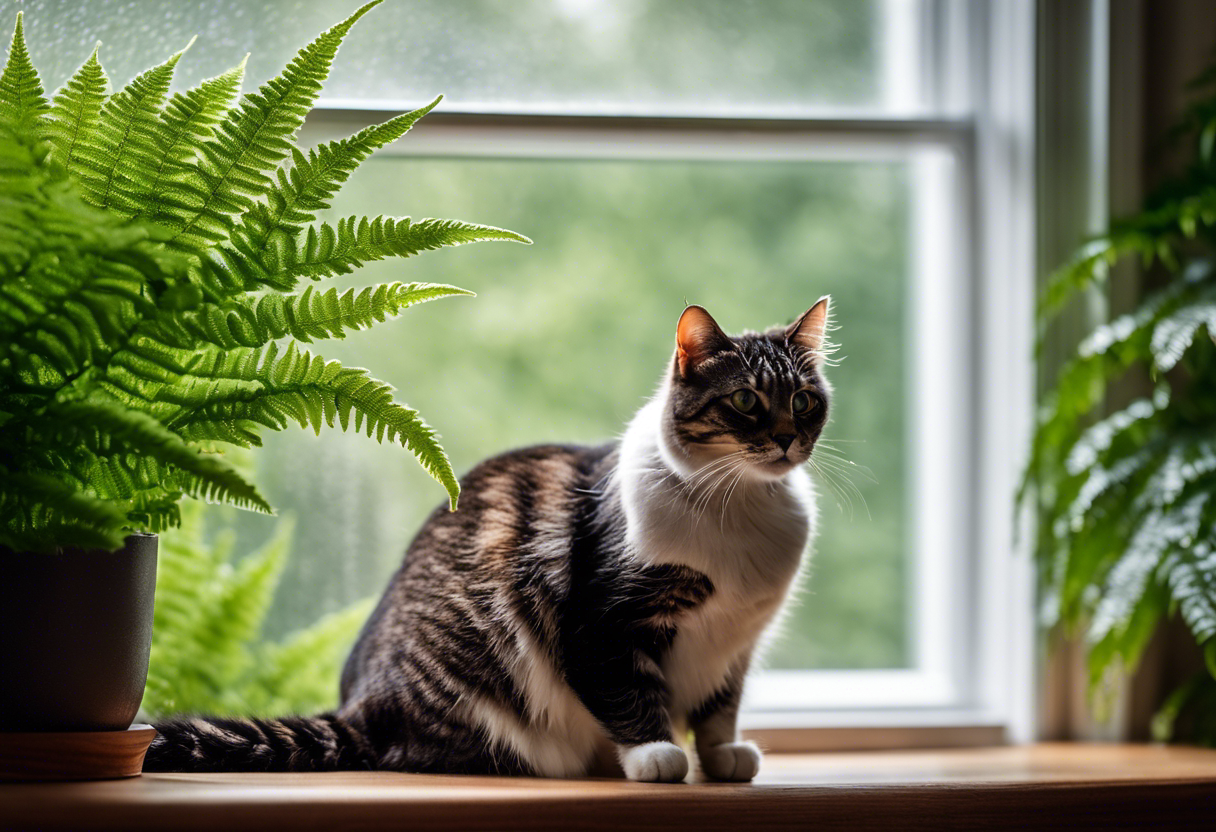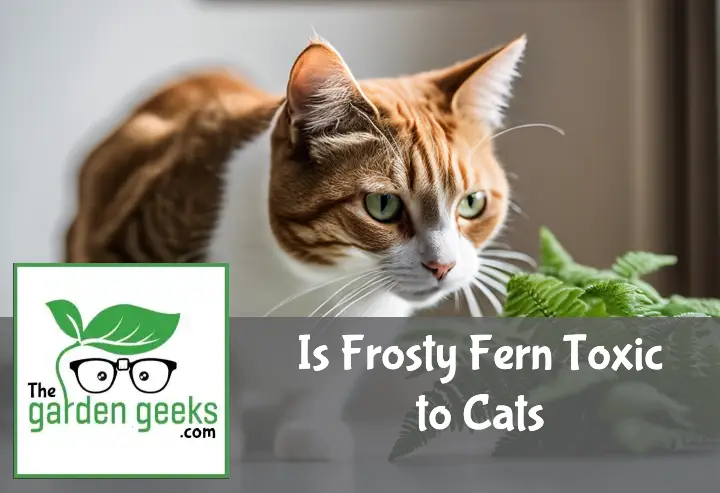You know, I’ve always had a soft spot for houseplants. They add a bit of nature’s touch to our homes, don’t they? But when you have feline friends around, you gotta be careful. Some plants can be harmful to them. So, the question that’s been bugging me lately is: Is Frosty Fern Toxic to Cats?
In this blog post, we’ll dive into the world of frosty ferns and cats. We’ll explore if these beautiful green creatures pose any threat to our purring pals or not. Keep reading about ‘Is Frosty Fern Toxic to Cats?’ It promises to be as exciting as chasing a laser pointer!
Key Takeaways
- Frosty ferns are not toxic to cats.
- Despite this, they can still cause mild gastrointestinal upset if ingested by cats.
- Symptoms may include vomiting, diarrhea, and loss of appetite.
- If your cat shows severe symptoms after eating frosty fern, consult a vet immediately.
- It’s best to keep frosty ferns out of reach from cats to prevent any potential issues.
What is a Frosty Fern?
A Frosty Fern isn’t your typical fern. In fact, it’s not even a true fern! It’s a clubmoss, known scientifically as Selaginella kraussiana. This plant gets its frosty name from the white-tipped leaves that give it an icy appearance.
Origin and Characteristics of Frosty Fern
The origin of Frosty Fern traces back to the subtropical regions of Africa. It’s an evergreen perennial with creeping stems that can spread out quite extensively. The physical attributes of Frosty Fern include small scale-like leaves arranged in dense whorls along the stem.
This plant has a unique growth pattern where it forms a low mat, making it perfect for ground cover or hanging baskets. The growth pattern of Frosty Fern is slow but steady, and with proper care, this little plant can become quite lush and full.
Common Uses of Frosty Fern in Homes
When it comes to using Frosty Fern at home, this plant is often used as an ornamental piece due to its unique appearance and easy maintenance. Its frosted tips add an interesting texture to any indoor garden or terrarium.
The aesthetic appeal of Frosty Fern lies in its delicate foliage that seems dusted with snow, making it a popular choice during the holiday season. But beyond aesthetics, there are other benefits too! Having a Frosty Fern can improve air quality by absorbing toxins and releasing oxygen back into your space.
Is Frosty Fern Toxic to Cats?

When it comes to cat safety and indoor plants, it’s crucial to know which ones are friends and foes. So, the million-dollar question is, “Is Frosty Fern toxic to cats?” Let’s dive in!
Understanding Cat’s Reaction to Frosty Fern
Cats are curious creatures, aren’t they? They love exploring new things, including your beloved Frosty Fern. But what happens if they take a bite? Well, some cats might experience discomfort or show signs of distress.
These symptoms could include drooling excessively or vomiting. In some cases, they may even have diarrhea or lose their appetite. It’s like having a bad hangover but for cats! Not fun at all.
Scientific Evidence on Frosty Fern’s Toxicity to Cats
Now let’s talk science! Unfortunately, there isn’t much concrete scientific evidence about the toxicity of Frosty Ferns to cats. Most of the information we have is anecdotal from pet owners and vets.
However, many experts in veterinary studies and plant toxicity research agree that it’s better safe than sorry when it comes to our furry friends and plants. So until more research is done, it might be best to keep your cat away from the Frosty Fern just in case!
Symptoms of Frosty Fern Poisoning in Cats
When it comes to frosty fern poisoning, our feline friends might not be as lucky as we are. They can’t just spit out the plant and say “Yuck!” So, let’s dive into the nitty-gritty of what toxic plants for cats like frosty fern can do.
Physical Symptoms
If your kitty has had a nibble on a frosty fern, you might notice some immediate symptoms. These could include drooling more than usual or vomiting. It’s their body’s way of saying, “Hey, that wasn’t tuna!”
But don’t think you’re off the hook if they seem fine right away. Some delayed cat reactions to frosty fern ingestion can occur too. You might see loss of appetite or diarrhea even days after they’ve chomped on that leaf.
Behavioral Changes
Now, onto how frosty fern effects on behavior can manifest. You know your cat better than anyone else and subtle changes in their behavior could be the first sign something’s up.
Maybe they’re not chasing that laser pointer with their usual gusto or they’re hiding more than usual. These subtle changes in cat behavior could be a clue that they’ve eaten something they shouldn’t have.
On the flip side, there may also be obvious behavioral changes in cats after eating a frosty fern. For instance, if your usually quiet kitty starts meowing excessively or seems unusually agitated, it’s time to ask: “Is Frosty Fern Toxic to Cats?” And the answer is yes! So keep an eye out for these signs and keep those pesky plants out of paw’s reach!
What to Do if Your Cat Ingests a Frosty Fern?
So, your feline friend has decided to snack on a frosty fern? Don’t panic! Here’s what you need to do when your cat ingests a frosty fern.
Immediate Steps to Take
First things first, remove any remaining plant material from your cat’s mouth. This will prevent them from swallowing more of the toxic plant. Now, observe your furry friend closely for any signs of frosty fern ingestion symptoms.
If they start showing signs like drooling, vomiting or diarrhea, it’s time to kick into high gear. You’re dealing with an emergency pet care situation here. It’s important that you keep calm and act swiftly.
When to Contact a Vet
Now, you might be wondering when exactly should you call the vet? Well, if your cat is showing severe symptoms like difficulty breathing or seizures, don’t hesitate! Dial up your vet immediately.
Signs of plant toxicity in cats can be subtle at times. So even if your cat seems fine after munching on the frosty fern but starts acting lethargic or refuses food later on, it’s time to ring up the vet.
Remember folks, when it comes to feline health emergencies, it’s always better safe than sorry! So keep an eye out for these signs and don’t hesitate to seek professional help when needed. After all, we want our furry friends happy and healthy!
Prevention Measures for Cat Owners
When it comes to Frosty Fern prevention, there are a few cat safety measures you can take. These include preventing cat ingestion and finding Frosty Fern alternatives. Let’s dive into these strategies.
Safe Placement of Frosty Ferns at Home
For starters, safe Frosty Fern placement is key. You might be thinking, “How do I keep my curious kitty away from this plant?” Well, it’s all about indoor plant positioning.
Consider placing your Frosty Fern in an area that’s out of reach for your feline friend. Maybe on a high shelf or inside a hanging basket? This pet-safe plant arrangement will ensure your cat stays safe while your fern flourishes.
Alternatives to Frosty Fern for Cat Owners
If you’re still worried about the question, “Is Frosty Fern toxic to cats?“, maybe it’s time to consider some alternatives. There are plenty of cat-safe houseplants out there that can add greenery to your home without the worry.
Spider plants, for example, are non-toxic plants for cats and make great alternatives to Frosty Ferns. Or how about some pet-friendly indoor plants like Boston ferns or Swedish ivy? They’re safe, they’re green, and best of all – they won’t give you any fur-parent anxiety!
To Wrap Up
So, after a journey as twisty as a cat chasing its tail, we’ve finally got our answer. Yes, Is Frosty Fern Toxic to Cats. And that’s no small potatoes, folks!
Remember, keep your feline friends away from this fern. It’s like feeding them their least favorite food – not a purr-fect situation!


